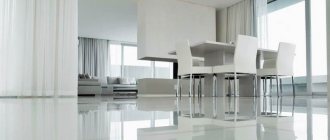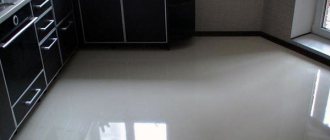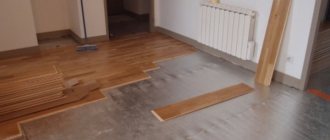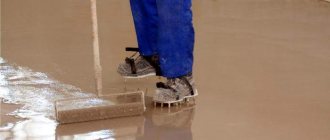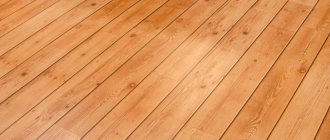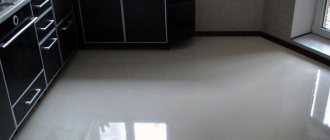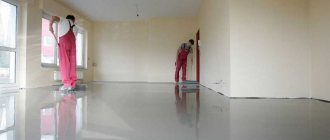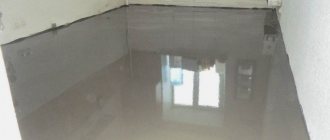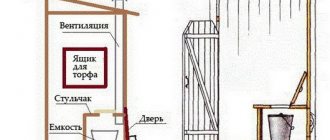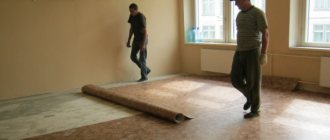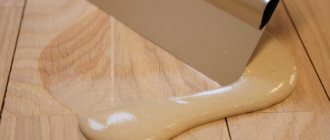When you first have to arrange DIY self-leveling self-leveling floor, many questions arise. For example, which materials to give preference to, which technology is considered the best and how not to make mistakes, due to which the finishing coating will soon have to be redone.
To order a self-leveling floor or screed device at the best prices in Moscow, visit this website: STROI-F.RU
What is a self-leveling self-leveling floor?
When spread, the liquid self-leveling floor creates a flat and smooth surface. Such models are an ideal option for the further installation of many types of floor coverings. A popular type of self-leveling floors are self-leveling structures, which are the final finishing.
Self-leveling floor is a type of coating obtained by filling the floor surface with a certain self-leveling mixture. It is characterized by high strength and perfect evenness. Outwardly it resembles linoleum, has no seams or gaps.
An important technical characteristic is the minimum thickness of the self-leveling floor. In the technology of self-leveling coatings, every millimeter is of great importance.
In an apartment, a layer of 1 mm is considered sufficient to forget about repairing the floor for a long time.
A self-leveling floor is not just a uniform, smooth surface on which there is nowhere for dirt to hide. Modern achievements make it possible to make the result of the work a real work of art with a colorful image in 3D.
A perfectly flat floor - why is it needed?
Even in a new building, there are differences in the floors. They can reach 10 cm. Today, panel slabs are laid so that the ceiling between floors with its smooth surface is directed towards the ceiling, and its lumpy surface towards the floor. And on this side, without screeds, you can only lay linoleum. The parquet will be constantly deformed.
Thus, we fill the floor according to two main reasons:
- Laying flooring.
- Construction of a floor with water or electric heating.
- Other floor insulation.
For your information
To get a perfectly even coating, we use cement filling. This operation is also called screeding. It is necessary before laying the topcoat. In this regard, many owners have a question about how to properly fill the floors in the apartment. This technology is not anything overly complicated. The main thing is to perform all operations correctly and step by step.
Features and advantages of self-leveling floors
In apartments and private houses, linoleum, laminate or ceramic tiles are used as flooring. In comparison with them, a self-leveling self-leveling floor has a number of advantages:
- linoleum lasts no more than 20 years, and self-leveling flooring lasts 2 times longer. In addition, when replacing the coating, the old linoleum is always removed, which is not required when updating the self-leveling floor;
- Laminate reacts negatively to moisture, so installing such flooring in a kitchen or bathroom is not recommended. In addition, the service life of the laminate is only 12 years;
- Ceramic tiles are not inferior to self-leveling floors in strength and resistance to moisture penetration. However, the presence of seams between tile elements contributes to the accumulation of bacteria and dirt;
- self-leveling floors are made from materials that are not subject to fire. They do not require complex maintenance, can withstand heavy loads, and are resistant to abrasion and moisture penetration;
- The high sound insulation characteristics of self-leveling floors have allowed them to be widely used in residential premises, whose owners prefer a quiet lifestyle.
Self-leveling floor, video:
Preparation steps before making a poured floor
For preparatory and main work we use the following arsenal:
- Reiki. They are necessary for beacons.
- Metal brush.
- Container for working personnel.
- Roller for priming.
- Sidewalk scraper.
- A small brush for applying primer to hard-to-reach or small areas.
- Putty knife.
- Needle type roller.
- Drill with a nozzle for mixing the solution.
- Primer.
You can fill the floors in your apartment correctly if you act strictly step by step. And the stages of work are as follows:
- Surface preparation. Removing old coating, cleaning from dust and dirt.
- Padding.
- Waterproofing.
- Thermal insulation.
- Checking horizontality.
Next comes the screed itself. Then we wait for the surface to dry and lay the base coating.
Have questions ? Call!
Main types of self-leveling floors and their thickness
The following compositions are used for the finishing layer when installing self-leveling floors.
Epoxy
They are used in laboratories and medical institutions where sterility is of great importance. The presence of a large number of coating methods has made epoxy self-leveling flooring popular in residential premises, and its high durability and wear resistance in factory workshops. Provides excellent protection for metal and wood surfaces.
Polyurethane
Coverings of this type are often installed in shops, warehouses, swimming pools and bathrooms. Polyurethane floors are resistant to conditions of high humidity and temperature changes, however, when the floor dries, moisture should not enter it due to the likelihood of bubbles forming.
Able to withstand mechanical loads and maintain strength under impact.
Polyurethane coatings are recommended for residential premises, as they are considered the most hygienic and safe for health.
Methyl methacrylate
The technology of laying the floor requires accelerated completion of the work, because the viability of the solution is short. The floors are not afraid of temperature changes and chemical influences.
Laying self-leveling floors made from methyl methacrylate mixtures is advisable in industrial facilities and even in open areas.
Polymer-cement
This is a separate category of coatings for industrial use. They are installed at facilities with difficult operating conditions: significant fluctuations in temperature and humidity, excessive loads.
These floors differ in their composition, but all belong to the group of polymer coatings.
The thickness of the self-leveling floor when using polymer materials is within a few millimeters. Polyurethane compositions make it possible to make a layer with a cross-section of up to 2.5 mm; this indicator is considered optimal.
If there is an intention to apply different colors to the coating surface, apply a thin layer of the composition, no more than 0.3 mm. The maximum recommended thickness of the polyurethane coating is 5 mm. A further increase in thickness does not make sense, especially since polymer floors are not cheap.
It is also preferable to apply epoxy-based compounds in a layer of 2.5 mm.
This thickness is enough for the floor to gain the necessary strength characteristics and not be fragile.
Rapid-hardening or methyl methacrylate mixtures can be used at moderate thickness. However, given that such floors are installed in rooms with heavy loads, you should not save. A coating that meets quality requirements must have a layer of 8–10 mm.
Epoxy look
It allows you to achieve masterpiece design results. Its advantages:
- Resistance to mechanical damage.
- Easy to clean.
- Transparency. You can arrange a composition under such a floor, then fill everything with the composition. Details on how to fill such a liquid floor in this video:
A must read
What floor to install in an apartment Warm floor in an apartment: a modern choice How to change floors in Khrushchev, Stalin, Brezhnevka
How to make a self-leveling floor with your own hands step by step?
First of all, you need to prepare the tools: a plastic or galvanized bucket for mixing the mortar, a construction mixer, usually a laser level, a roller with needles to remove air bubbles.
In the process of work, you will need a lot of all sorts of secondary tools and devices, but there is no need to list them, because this equipment is necessarily present in every home.
Preparing the base
It is a mistake to believe that if the base is hidden under the finishing layer, its preparation can be taken lightly. The base is the foundation of the future floor, and the final result of the work depends on how it is prepared.
By laying the solution on a dusty base without priming it, you can soon see the appearance of cracks, which can lead to peeling of the material. Therefore, the floor on which the finishing layer will be applied should be cleaned of debris, dust and any contaminants.
Weak areas should be removed and cracks and voids filled with epoxy putty.
When the base is heavily contaminated with fatty substances and its strength is questionable, experts advise using a separating layer. The damper tape for self-leveling floor will ensure a strong floor screed and the tightness of the structure.
The last stage of working with the base is its primer. The primer composition is applied to the surface with a brush or roller in several layers.
The primer for self-leveling floors requires mandatory drying of at least 12 hours between layers.
It is not necessary to buy the material in a store; you can prepare it yourself from a dry composition for self-leveling floors. The main thing is that the primer composition has deep penetration or strengthening properties.
Mixing the solution
Instructions for use are always included on the packaging of the purchased material. One of its main points is the consumption rate of components.
A precisely measured volume of water with a temperature in the range of 15–20 °C is collected in the bucket. The liquid must be clean and free of impurities. Gradually, the dry mixture is added to the bucket and mixed with a mixer to form a homogeneous solution.
During work, it is necessary to use personal protective equipment: goggles, gloves, respirator. They will be needed when installing self-leveling floors using cement-based materials.
Such materials, when in contact with water, form an alkali, which is dangerous if it comes into contact with skin or eyes.
Pouring the mixture
Despite all the responsibility, this stage is not considered difficult. Using a laser level, the height difference of the base is determined, which allows you to calculate the thickness of the finishing layer.
If a floor heating system is installed, it should be turned off two days before the start of work, and turned on again 5-7 days after the floor is installed.
Pouring of material begins from the corner of the room farthest from the entrance. The mixture itself will immediately begin to spread over the base, taking its final position, but it still cannot be done without manual finishing.
To maintain the required floor thickness, you will need to use mathematical knowledge: it is necessary to link the area of the room with the flow rate of the mixture.
Floor hardening time
Before starting work, it is important to know how long it takes for the self-leveling floor of the selected type to dry. The main thing is that the need to use the floor does not occur before the drying process is completed.
Typically, a self-leveling or polymer floor dries from 2 to 6 days; the drying time is affected by the structural composition of the mixture, the quality of the fill and the thickness of the layer being installed.
The drying time of a polyurethane floor is about two days, and you can walk on it after 6–10 hours. The time for complete drying of an epoxy floor increases to 5 days.
To ensure that the self-leveling floor dries correctly, you should use a few tips:
- when the distributed mixture dries a little, it must be covered with a film that will protect the surface from dust, debris and foreign objects;
- After the first stage of drying, allowing you to move on the floor, it can be coated with a protective varnish containing a polyurethane base. Varnish will add durability and beautiful shades to the coating;
- It is recommended to protect the floor from direct sunlight and ensure a constant temperature in the room. This will reduce the drying time of the coating.
How to fill a self-leveling floor? Video:
Pouring process
How to fill the surface of an existing base more efficiently? If all measures for leveling have already been provided, then the process should be completed in one day. This is the key to uniform composition.
Filling begins from the far corner of the room. To level the layer, apply the rule. We evenly distribute the material within the boundaries of the fixed beacons.
Using a needle roller, remove air from the mixture. This way we exclude the occurrence of internal voids in it. Then we level the screed completely. We repeat the operations until the base is completely filled.
If you have some misunderstandings, you can watch a video of how to pour a floor screed with your own hands.
How to properly fill a self-leveling self-leveling floor with your own hands?
The decision to fill the floor yourself is made when there is a desire to test your abilities or save money that you will need to pay a specialist for the completed order.
Anyone who has at least basic knowledge can cope with the job. The main thing is less improvisation and more compliance with the requirements of the instructions.
Basic recommendations on how to make a self-leveling floor yourself have already been discussed. At the final stage of work, several useful tips will come in handy:
1. If the layer thickness is less than 1 cm, the prepared mixture must be poured onto the base and carefully distributed with a rule or squeegee.
If the thickness is more than 1 cm, it is recommended to install beacons for the self-leveling floor. These reference devices are installed on the work surface at regular intervals.
2. After finishing pouring the floor, it’s time for aesthetic measures, for which you will need a needle roller for self-leveling floors. By rolling it over a coating that has not yet hardened, you can prevent the formation of bubbles and further compact the mixture.
If expansion joints were installed in the base of the floor, they will need to be restored in the finishing layer. In order not to leave footprints on the drying surface, it is recommended to wear paint shoes - special soles with spikes.
3. During work, drafts in the room are not allowed. All windows and doors in the room must be closed so that drafts do not disturb the evenness and strength of the coating. After applying a thick layer, it is advisable to cover the surface with plastic film - this will ensure uniform drying.
4. You should not work on floors if you have not had any practice before. Theoretical knowledge does not guarantee a successful result. For the first time, you can be an assistant to a neighbor or friend.
Surface grinding
If you couldn’t avoid mistakes when pouring the floor, you shouldn’t be upset: no one is immune from them. Sanding the self-leveling floor will help correct many visible defects.
You need to start it after marking the boundaries of the holes and bulges. If the self-leveling floor does not serve as the front surface, then the holes can be covered with the main mixture. After it has dried, you can begin to remove the bumps with a grinding machine.
How to choose an air conditioner for an apartment or house? - there is more useful information here.
It is not recommended to sand polymer floors to a depth of more than 2 mm: the applied layer may lose its strength.
In addition, the presence of reinforcement and other metal products in the processed plane is excluded. Otherwise, it will be impossible to complete the grinding process.
When sanding, a large amount of dust always arises. Because of this, you should not wet the floor with water: the sander will begin to slip, and wet chips will begin to accumulate on the working surfaces.
You will be interested in this article - Monolithic house: construction technology, pros and cons.
Surface level and placement of beacons
Many owners are interested in how to fill the floor in an apartment efficiently and evenly? To do this, be sure to determine the level of the screed and install beacons (special slats).
Using a level, check the evenness of the base. We indicate the level of the intended coverage on the walls.
From plastered areas, remove the plaster 0.25 cm above this line. Using these notations we identify the highest point of the surface. This is a guarantee of proper filling.
Here the working algorithm is:
- We measure 1 m up the wall, counting from the door threshold. We draw a line.
- We draw a line around the perimeter of the room. We maintain its parallelism using a level.
- The second parallel is drawn at a distance of 1 m under the control symbol.
- We drive nails into the corners of the room on the bottom line and stretch the wire.
Thanks to the marks on the load-bearing components, it is easier to place beacons in a new apartment. The distances between beacons correspond to the length of the rule. We apply the rule to level the mixture.
The final result depends on the placement of the slats. After all the work, the slats are removed. They leave recesses that can easily be filled with the same solution that was used for the screed.
With guidelines it is much easier to fill the screed. And so we get the necessary flat surface. We install beacons even for work on a small area.
Bedding question
Before you make the working composition and pour it onto the required area, you need to make a bedding. This is the so-called pillow. It consists of three layers.
- The initial one is gravel. Density: 5 -10 cm. Water it with water and tamp it down. To control the thickness of the layer, be sure to drive pegs directly into the soil. We put them by level. Having slept and compacted this layer, we take them out.
- The second one is sandy. Density -10 cm. We also adjust the thickness with pegs. We water the sand and compact it using a vibrating plate.
- Shchebnevy. Thickness – 10 cm. We carefully level it and make it denser. There should be no sharp edges on the surface. Suitable crushed stone has a fraction of 4-5 cm. After compaction, sprinkle it a little with sand and tamp it again.
Horizontal level adjustable
Video guide for installing beacons
Decorative self-leveling floors
Construction stores offer a large selection of self-leveling floors with decorative patterns and three-dimensional perception. After preparing the concrete base using the traditional method, the further technology for pouring a self-leveling floor with a 3D effect is as follows:
- a synthetic banner canvas is selected, onto which the image you like is applied using high-precision laser printing;
- the fabric is ideally smoothed over the primed surface and glued to it using polymer glue; excess pieces of material near the walls are carefully cut off;
- After 1–2 days, necessary for drying the adhesive layer, you can begin to create a highly filled coating. Quartz sand, marble chips, and various decorative elements are used as fillers, which are scattered over the canvas and carefully leveled;
- if necessary, a hardener is added to the polymer mixture, after which the compound is poured onto the floor and leveled, with the obligatory removal of bubbles;
- The floor should be poured in several stages until the fillers are completely covered with the mixture. In addition, layer-by-layer pouring allows you to reduce the polymerization time;
- the formation of the coating ends no earlier than after 10 days.
Despite the fact that the effect of a three-dimensional image is perceived only from one point in the room, the resulting result will meet expectations.
Creating an absolutely flat surface is a mandatory requirement when installing modern floor coverings.
Having studied all the recommendations on how to make a self-leveling floor, you can do the work in your own house or apartment yourself, if necessary, involving not an expensive specialist, but a good friend. Already as an assistant.
Drawing a picture on the floor
Begin your 3D patterned floor installation by selecting an image. This could be an image from the Internet or even your own creation. When downloading an image from the Internet, make sure it has a resolution of at least 300 dpi.
It is best to look at the floor with a depth effect. It could be an abyss, a body of water. The water theme is generally popular as it looks beautiful in any room and has a nice calming effect.
How to choose the right image for the floor
Which flooring image is not recommended to be used:
- pictures with monsters . Aggressive drawings can put pressure on the psyche and cause unpleasant sensations.
- dynamic images . They can negatively affect people with a weak vestibular system;
- too bright and large pictures , flashy colors and aggressive combinations. It is difficult to relax in such a room, and the abundance of colors (especially red) is a strong stimulant for the psyche;
- little things magnified to enormous sizes. It will look tasteless and get boring very quickly.
Blend selection
We select the mixture based on the thickness of the fill and the composition of the mixture.
Based on the content of the first section of the article, we understand that the choice of mixture based on the thickness of the fill depends on the measured unevenness of your floor. There is no need to take a mixture for filling 50-100 mm if you need to eliminate unevenness up to 10-20 mm. Its composition will be too rough for thin fills.
The choice of mixture according to composition is a choice between gypsum and cement self-leveling floors. I talked about them in detail in the article here. Briefly, gypsum is afraid of water, but dries quickly, self-leveling cement floors are suitable for wet rooms, but complete drying takes 20-28 days.
